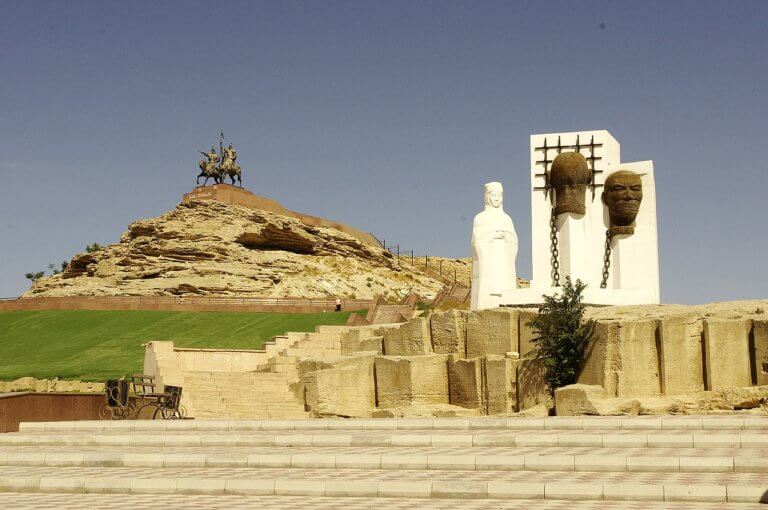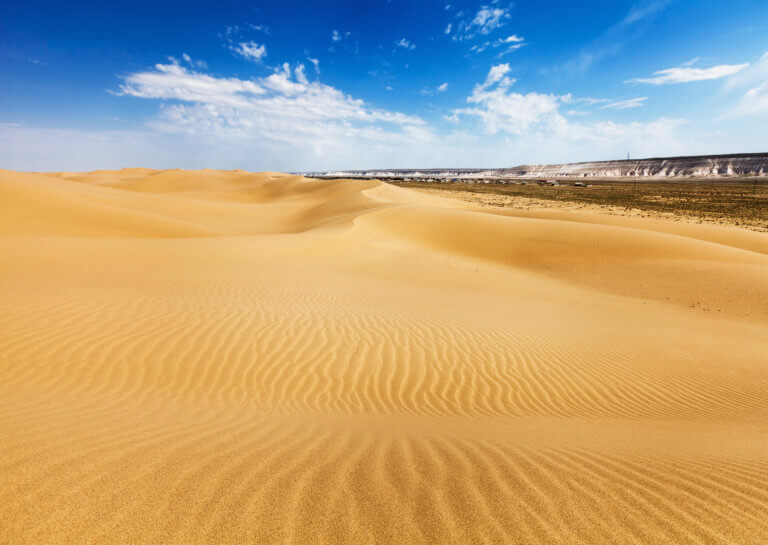
Fort Shevchenko and Bautino
Perched on the western tip of the Tub-Karagan Peninsula is the city of Fort Shevchenko and its satellite port town of Bautino. It’s the Mangystau
Ten kilometres off the north coast of the Tub-Karagan Peninsula is the Tyuleniy Archipelago. Tyulen means ‘seal’ in Russian. The archipelago comprises five named islands. Kulaly and Morskoy are the largest and westernmost islands and measure 20–30km in length. The other three are the arid and inhospitable Novy, Rybachy, and Podgorny. The nearest place to arrange a boat is Bautino Port, 30km south of the archipelago and adjacent to Fort Shevchenko.
Kulaly has the remains of a New Stone Age settlement, a meteorological station manned by the archipelagos’s only permanent resident, and the country’s only maritime border post. The main job of the guards is to catch poachers, some of whom come across from Russia to fish in Kazakh waters.
Journalist Andrey Mikhailov, one of the few who have ventured to the islands, described Kulaly as flat, bare, and lifeless, composed mainly of sand and broken shells. Despite the sparse feel of the place, Mikhailov detected the subtle liveliness of the island, with sea snakes slithering through swaying reeds at dusk and the air thick with the buzz of mosquitoes. Above the sea, gulls, cormorants, green bee-eaters, and terns gracefully soar, adding life to the landscape.
Scholars credit Dutch cartographer and architect Cornelis Kluytting’s Paskaert van de Caspise Zee (1665) as making the first step towards a realistic depiction of the Caspian Sea. Compared to earlier Dutch maps*, Kluytting’s featured more river mouths, islands and, crucially, an oblong-shape perimeter instead of circular or oval forms in earlier maps, reflecting a significant advancement in recognising the sea’s true, less-than-symmetrical coastline. Nicolaes Witsen used this map in his book about the Caspian region, Noord en Oost Tartarije, which provided a detailed description of the coastline, along with an updated version of his own 1687 map that is said to depict the archipelago for the first time. Prior to this, Johannes Struy’s 1676 map – the first to represent the sea as a kidney shape – showed only Kulaly (marked as “Kallolee”).
Comprehensive hydrographic and cartographic studies of the sea commenced during Peter the Great’s reign from 1682–1725. Motivated by the goal of establishing a navigable route from Russia to Central Asia and India, he focused on detailed surveys of this area. The first reasonably accurate maps of the Caspian Sea emerged from surveys in the 1710s undertaken by Bekovich-Cherkassky and a joint expedition between Fedor Ivanovich Soimonov and Dutchman Karel van Weerden. Allegedly, there was a separate operation by cartographer Alexander Kozhin and lieutenant-prince Vasily Urusov, too.
The most notable event in the archipelago’s history, although difficult to verify, took place in 1667 when 200 anti-tsarist rebels, siding with Cossack leader Stenka Razin, fled from Atyrau to the islands in fear of retribution. When news reached Russia’s noblemen, they sent 40 boats with 2,500+ archers – armed with cannons – to sail across the northern Caspian and attack the Cossacks on Kulaly. With a fort-town constructed out of sandbags, the rebels didn’t stand a chance against Russia’s firepower and the few that survived were swiftly executed.
* Abraham Ortelius, Persici sive Sophorum Regni Typus (1570); Jodocus Hondius, Tartaria (1606); Willem and Joan Blaeu, Tartaria sive Magni Chami Imperium (1634); and Joannes Janssonius, Persia sive Sophorum Regnum (1636).
Until the early 20th century, the islands were a major breeding ground for Caspian seals. Kulaly’s northern part had barns and buildings used for seal fat storage, light processing of sealskins, and for housing seasonal seal hunters.
In the 19th century, up to 500 seal hunters would arrive on Kulaly for the season. Estonia-born Karl Maksimovich Baer*, a renowned scientist and explorer of the Caspian Sea in the 1850s, recounted meeting a slightly inebriated team of hunters from Astrakhan, who had brought vodka with them for the winter. The hunters generously offered eggs to Baer, and even chickens, indicating poultry farming on the island. He also noted watermelon cultivation, although they tended to be small. Two decades earlier, the islanders experimented with grain cultivation, resulting in successful oat crops but poor wheat yields. Baer observed a significant number of dogs on the island, too, used primarily for aiding in the retrieval of seals from the shore during winter.
It was dangerous work as groups of hunters would occasionally get caught out on the open sea as ice floes separated and drifted away from the land, or drown offshore in summer storms. These days, seals are a rare sight on the islands and researchers believe that creating artificial islands would encourage them to return
* Founding member of the Russian Geographical Society and also known as Karl Ernst von Baer.
Tyuleniy Archipelago (Tiulenii Araldary/Острова Тюленьи): 44.8954, 50.4400
Kulaly Island (Qūlaly Araly/Остров Кулалы): 44.9343, 50.0305
Morskoy Island (Morskoi Araly/Остров Морской): 45.0123, 50.2998
Rybachy Island (Rybachi Araly/Остров Рыбачий): 44.8035, 50.3653
Novy Island (Novyi Araly/Остров Новый): 44.9199, 50.7185
Podgorny Island (Podgornyi Araly/Остров Подгорный): 44.8089, 50.5892
Bautino (Bautin/Баутино): 44.5450, 50.2540
1:500k Soviet map of the Tyuleniy Archipelago, shown on the right side. The Volga Delta is in the top left.
1:200k Soviet map showing the five Tyuleniy Islands.
Article about Kazakhstan’s lighthouses.
A 2015 report about the Russian Geographical Society’s visit to the Tyuleniy Archipelago.

Perched on the western tip of the Tub-Karagan Peninsula is the city of Fort Shevchenko and its satellite port town of Bautino. It’s the Mangystau

Aktau serves as a perfect starting point for journeys into the Ustyurt and the broader Mangystau Region. Its strategic location on the Caspian Sea, coupled

Senek Sands, also known as Tuyesu Sands, is an 11 x 30km area of dunes located halfway between Zhanaozen city and Boszhira. Barchan dunes cover